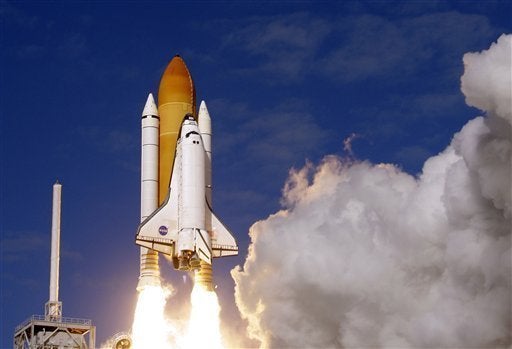
I am an absolute space geek. The only time I ever skipped high school was to hear a panel of astronauts give a talk about space exploration. I owned a topographical map of Mars before it was ever considered cool (it IS considered cool, by the way). And this past July I was one of the lucky few that joined the team of Apollo 11 to commemorate the 40th anniversary of their moon landing. I have always been a firm supporter of NASA and its space exploration program; it is truly the stuff of dreams (including mine). Yet, for the first time, I am finding myself extremely disappointed by NASA's efforts to pursue the final frontier. During a time when NASA's budget is especially tenuous and after the Obama administration essentially put the agency's human spaceflight plans on hold, I am bewildered by NASA's plan to squander nearly $2 million in taxpayer money on radiation experiments on monkeys.
NASA has announced it is funding an experiment in which as many as 30 squirrel monkeys will be exposed to harmful ionizing radiation here on Earth. The purported goal of this project is to observe how radiation exposure during extended trips through deep space may affect astronauts' neurochemistry, cognition, and behavior. Ultimately, the experiments are poorly planned and a far cry from the real life conditions humans would be confronted with in space.
On long trips to space, astronauts are continuously exposed to low levels of radiation, but the monkeys in the NASA experiment will be exposed to a single, large dose of radiation over a period of just a few minutes. The biological effects of these two very different kinds of exposure vary substantially. For example, in small doses over a lifetime, the radiation we are exposed to during diagnostic medical procedures is relatively safe. But if one were exposed to all of that radiation at once, one could suffer from health complications including vomiting, seizures, skin and bone marrow damage, internal bleeding and increased risks of cancer.
According to government documents, after the radiation exposure at the Brookhaven National Laboratory, the monkeys will be taken to a Harvard facility where they will be individually confined to steel cages. They will be strapped into restraint chairs and forced to perform behavioral tasks like pressing levers or touching a computer screen in response to visual stimuli. This will go on for five days a week for at least four years, allowing the experimenters to observe how the radiation exposure causes the animals' physical and mental health to deteriorate. The monkeys will spend the rest of their lives in cages. NASA says there are no further plans for them at this time, but the radiation study could be renewed in four years or the monkeys may be used in additional experiments later on.
Any cognitive and physical deficits that the monkeys might suffer as a result of being irradiated will be confounded -- and potentially magnified -- by the debilitating impacts of their confinement and manipulation. In the laboratory, the monkeys will be denied meaningful social interaction, physically tormented, confined to highly unnatural environments, and deprived of everything normal to them. This environment -- inherently detrimental to the monkeys' physical and mental health -- will render the results of the experiment extremely difficult to interpret.
Additionally -- and here's the real problem -- this experiment will only help tell us how the monkey brain is affected by radiation, not the human brain. While monkeys are intelligent and social creatures and share many characteristics with humans, key differences exist between the neuroanatomy and neurochemistry of monkeys and humans. Not to mention the many differences that we aren't even aware of yet. These known and unknown differences will make it almost impossible to unravel and determine what results, if any, from the monkey experiment can and cannot be applied to humans. At best we will come away $2 million poorer with information that we won't know how to safely apply, and at worst, we will be misled by the results of this experiment in ways that can seriously jeopardize the safety of future astronauts.
Four decades of radiation experiments on monkeys have cost thousands of animals their lives and taxpayers millions of dollars, yet have provided hardly any useful information about the effects of space radiation on humans. In fact, the government's program for conducting these experiments was halted in the 1990's largely for this very reason. Another one, 100, or 1,000 monkey studies will not tell us how human beings will be affected by space radiation on a trip to Mars, or anywhere for that matter.
NASA's space program relies on incredibly sophisticated technology and represents a triumph of human ingenuity and imagination. This experiment is a step backwards for a forward-looking organization and contradicts what is best about NASA.
Aysha Akhtar MD, MPH is a fellow of the Oxford Centre for Animal Ethics and a double Board-certified neurologist and public health specialist with the Food and Drug Administration. She serves on several advisory committees for the protection of humans in research.
The opinions expressed here are those of the author and do not represent the official position of the U.S. Food and Drug Administration or the U.S. government.